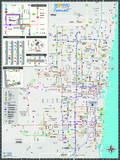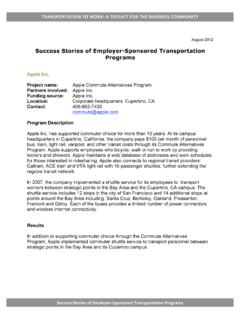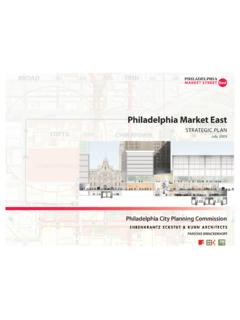Transcription of TRANSIT ORIENTED DEVELOPMENT (TOD) …
1 Defining TOD These TOD Success Stories selected from projects across the country show how TOD can create dense, walkable mixed use areas around stations that generate economic DEVELOPMENT and more vibrant communities. Typically, TOD occurs within 1/4 to 1/2 mile, or within a 5 to 10 minute walk, of a TRANSIT station. TOD is character ized by: A mix of uses, Moderate to high density DEVELOPMENT , Pedestrian orientation/connectivity, Transportation choices, including walking, biking, and the use of TRANSIT , and Urban design and landscape features that integrate surrounding uses and streets.
2 Experience from other cities demon strates that implementing TOD can result in significant benefits to individuals, communities and entire regions by improving the quality of life for people of all ages and abilities to live, work, shop, learn and play. Conventional DEVELOPMENT often consumes acres of land, requires extensive investments in infrastruc ture, and perpetuates dependence on private vehicles. TOD reduces travel time, shortens journeys and provides non motorized trip options, helping to reduce our reliance on the automobile. The following case studies illustrate how TRANSIT supportive policies, planning and coordinated investment in land use and transportation can create opportunities for TOD.
3 New Haven Hartford Springfield Rail Program TRANSIT ORIENTED DEVELOPMENT (TOD) SUCCESS STORIES BALTIMORE STATE CENTER TOD: This 110-acre site in midtown includes government offices, new retail, public space and subsidized housing. For more information on TOD and the NHHS Rail Program, please visit HIGHEST DENSITY AT THE STATION: TOD typically occurs within 1/4 to 1/2 of a TRANSIT station with the immediate area around the station (core area) generally containing the greatest intensity and mix of uses. Benefits of TOD Community Benefits Encourages use of non motorized transpor tation By integrating land use and transportation planning, residents and visitors to TOD communities have convenient TRANSIT options to desired destinations.
4 Provides a balanced approach to accommo dating growth TOD directs higher density DEVELOPMENT to appropriate areas near TRANSIT stations, reducing pressure to build higher density DEVELOPMENT where it is not appropriate. Creates compact, sustainable urban form TOD uses infill, greyfield and brownfield sites to redevelop and intensify existing urban areas, consuming less land while lowering infrastructure costs. Enhances local economic DEVELOPMENT TOD is increasingly used as a tool to help revitalize neighborhoods and to enhance tax revenues.
5 Promotes more sustainable Infrastructure TOD can help reduce infrastructure costs by up to 25 percent through more compact DEVELOPMENT and the incorporation of green infrastructure strategies. Increases land values Locations with access to TRANSIT can enjoy increases in land values in comparison to locations away from TRANSIT stops. Increases public safety By creating active places that are busy through the day and evening and providing eyes on the street, TOD can help increase safety for pedestrians, TRANSIT users, and many others.
6 New Haven Hartford Springfield Rail Program TRANSIT ORIENTED DEVELOPMENT (TOD) SUCCESS STORIES Personal Benefits Increases mobility choices By creating activity nodes linked by TRANSIT , TOD provides much needed mobility options for young people, the elderly and people who do not own cars or prefer not to use a car for the trip. Increases disposable household income TOD can effectively increase disposable income by reducing the costs of owning and operating a vehicle. Increases health benefits TOD promotes a healthy lifestyle by making it convenient to walk and by providing the infrastructure that supports walking and biking.
7 For more information on TOD and the NHHS Rail Program, please visit Residents in TRANSIT rich neighborhoods spend 16% less on transportation than those living in exurban neighborhoods. Center for TRANSIT ORIENTED DEVELOPMENT Concord Commons Concord, Massachusetts The Concord Common DEVELOPMENT comprises three mixed use buildings with retail space, office space, a 180 seat restaurant, and 20 rental apartments. The Concord Commons DEVELOPMENT is just one element of a vibrant mixed use neighborhood surrounding the Concord Center commuter rail station.
8 The old station building represents a stunning example of historic train stations of the mid 1800s. This meticulously preserved building houses an upscale general store and a restaurant. A mix of retail and office uses line both Thoreau and Sudbury Road within an easy walk to the station. The zoning required 146 parking spaces for the mix of uses proposed. However, the developer negotiated a 15% parking reduction by demonstrating successful shared parking strategies. 15 spaces are dedicated for commuter parking. The Planning Board negotiated a reduction in the impervious lot area from acres to acres, which allowed for a landscaped garden amenity for residents.
9 A landscaped pathway was incorporated by the developer connecting Sudbury Road to the station platform, providing a more walkable connection to the town center. Finally, because the Concord Common DEVELOPMENT directly abuts an established residential neighborhood, the developer designed the building facing the residential street at a scale that blended well with the existing housing, and provided a vegetative green buffer between the parking lot and the neighborhood. Source: New Haven Hartford Springfield Rail Program Key Site Statistics TRANSIT SERVICE Commuter rail DEVELOPMENT 20 rental apartments Mixed use retail and office 180 seat restaurant KEY FEATURES Reduced parking requirement with shared parking Stormwater management system reduced impervious surface New pedestrian pathway to link new mixed use DEVELOPMENT to the station TRANSIT ORIENTED DEVELOPMENT (TOD)
10 SUCCESS STORIES SMALL TOWN SUSTAINABLE TOD downtown Arlington Heights Arlington Heights, Illinois The village of Arlington Heights, west of Chicago, on Metra s Union Pacific Northwest Line, has seized upon TOD as an integral component of the city s award winning strategy to revitalize its historic downtown . The village has created a virtually new town center that includes a new Metra station, a perform ing arts center, high density housing, commercial uses, and public parking decks. In 1980, 350 residents lived in the downtown in 150 units. By 2000, the numbers jumped to 2,200 residents and 1,500 units.




